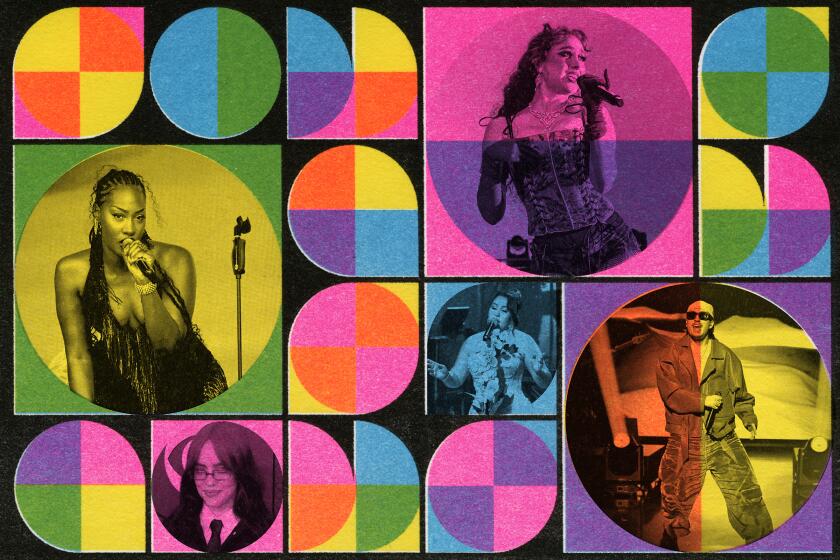Made for talkin’
- Share via
They hardly know each other but Nancy Sinatra and Michelle Phillips have plenty in common. They both topped the record charts in the mid-1960s: Sinatra with “These Boots Are Made for Walkin’ ” and Phillips, as part of the Mamas & the Papas, with “Monday, Monday” and “California Dreamin’.”
Phillips, 59, and Sinatra, 63, produced musical events during an era when female producers were rare. Sinatra went unheralded as executive producer of her own Emmy Award-winning special “Movin’ With Nancy” in 1971, and Phillips is seldom credited for her work on the 1967 Monterey Pop Festival.
But they’ll be the toast of the fifth Mods & Rockers Festival, the American Cinematheque’s tribute to 1960s cinema at the Egyptian Theatre (Thursday through July 15). A salute to Phillips and a screening of the film “Monterey Pop” open the festival, and a Saturday tribute to Sinatra includes a choir of 50 children singing “These Boots Are Made for Walkin’.”
Over tea recently, the singers compared notes.
How difficult was it to be taken seriously as a female producer in that era?
Phillips: I didn’t get any credit for producing Monterey Pop. That went to John Phillips and Lou Adler. I worked every day, the same hours that they did. They did the most important work on the festival. It’s just the way things were. I didn’t ever expect to get any credit.
Sinatra: [“Movin’ With Nancy”] was my idea, my concept. I hired the people. I wanted it to have a documentary feel and not be a static variety show in the studio. I got no credit whatsoever.... I look at “Sex and the City” and I see “executive producer Sarah Jessica Parker” and say “Yes!” because now it’s an everyday occurrence.
Michelle, you were married briefly to Dennis Hopper and Nancy, didn’t you date him?
Phillips: Oh my God!
Sinatra: No, I met him once during the shooting of “Wild Angels.”
Phillips: He probably said that he dated her.
Sinatra: I don’t even know that I actually met him on that shoot. But he was there. He was hanging out with Peter Fonda and I guess they were plotting “Easy Rider” at that point.
Phillips: I’d just like to clear something up. I was only married to him for eight days. So, it wasn’t that big of a mistake. It was a mistake that I realized quickly and rectified as quickly as possible. [Both laugh.]
Nancy, your album cover for “Sugar Town” featuring you in a skimpy bikini was banned briefly in Boston in 1966. Do the explicit lyrics, album covers and videos of today shock you?
Sinatra: Nothing shocks me, but I am disappointed when the people who are behaving in a sexual way don’t feel it. I don’t see any soul coming through the eyes. I see little machines, little robots, that are dressed up in their skimpy little outfits ... but I don’t see anything behind the eyes.
Phillips: It’s an exploitation of young people and young bodies. Labels and their parents and everybody else involved wants to exploit that sexuality as much as possible because that’s what they’re selling. They’re not really selling great music.
What appeals to you both about “California Dreamin’ ”?
Phillips: It talks about the hope for a better life, the hope for a better time. I can’t tell you how many people have said, “When I heard ‘California Dreamin’ ’ for the first time I packed up my VW van in Cincinnati in the teeth of winter and came to California....”
Sinatra: The harmony was so incredibly great. I did it on “The Ed Sullivan Show” once and they dressed me in this coat with a hood with fur all around the face in an ice-castle kind of scene.... I recorded it back in the ‘60s and it’s on my “California Girl” album from last year.
Are you surprised at how much came from “These Boots Are Made for Walkin’ ”?
Sinatra: That song had a life of its own from the beginning. Anybody could have sung that song. I just got lucky and ran into it when I did.
Michelle, were you intimidated by the performance of Jimi Hendrix at Monterey?
Phillips: I was shocked. When he pulled out that little can of lighter fluid and put it to his crotch and squeezed it all over his guitar and then set fire to it and then banged it until it was in a thousand different pieces, I had never seen anything like it before
The Monterey Pop festival broke the mold, didn’t it?
Phillips: Monterey was the first, and it was the best. [It] introduced so many people to acts that they would have never seen: Janis Joplin, Jimi Hendrix. It was a real cultural experience.
-- Michael T. Jarvis
More to Read
The biggest entertainment stories
Get our big stories about Hollywood, film, television, music, arts, culture and more right in your inbox as soon as they publish.
You may occasionally receive promotional content from the Los Angeles Times.










